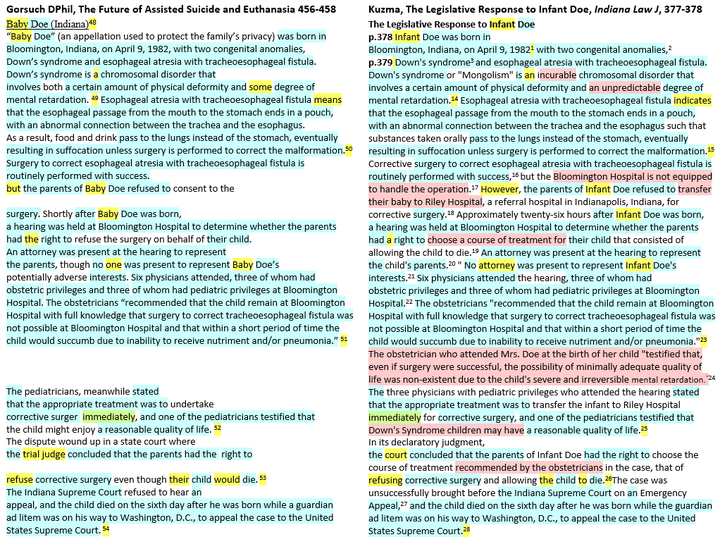
Gorsuch(2004) vs Kuzma(1984) Body, shaded

Gorsuch(2004) vs Kuzma(1984) Notes, shaded

Legend and statistics for Body + Notes
Yesterday, Neil Gorsuch was sworn in as a Supreme Court Justice. On 04/04/17 BuzzFeedNews published 2006 Book Appears To Be Copied From A Law Review Article and Politico published Gorsuch's writings borrow from other authors, getting wide coverage. Their hard work identified potential plagiarisms by Gorsuch, especially of a 1984 paper by Abigail Lawlis Kuzma. Some agreed this was plagiarism, others disagreed strongly.
Over years, a few people have evolved the plagiarism display style used above. It may help people form opinions. (Zoom In, Chrome Ctrl+ for example, if font too small.)
In 1984, Kuzma wrote "The Legislative Response to Infant Doe,” a detailed 40-page paper with 289 footnotes. In 2004, Gorsuch published his Oxford University DPhil dissertation The right to receive assistance in suicide and euthanasia, with particular reference to the law of the United States, of which the “Baby Doe” section, pp.456-458 is shown above left. Gorsuch’s 2006 book, The Future of Assisted Suicide and Euthanasia (Amazon, also Google Books or free PDF) has p.192 Body and pp.277-278 Endnotes, identical but for minor font changes.
Above at right are the text sections of Kuzma(2004) copied into Gorsuch(2004, 2006) at left. The shading and statistics are described here, showing that 82% of the words were identical, in-order. However, this display also exposes the edits in ways that can offer much insight.
“Baby Doe” <- “infant Doe”?
The actual case used “Infant Doe,” as Gorsuch recognized in footnotes 48,51,52,53, but he changed “Infant” to Baby” 5 times in the Body. Most early articles such as Chicago Tribune(1983) or Hagenbauch(1983) used “Infant” A few such as Pless(1983 p.12) mixed “Infant” and “Baby. Later Chicago Tribune(1986) and others used only “Baby.” Over time, other cases came to be called generically “Baby Doe” cases, leading to “Baby Doe” laws and lawsuits. “Baby Doe” protects family privacy no better than “Infant Doe.”
It is unclear why Gorsuch took the trouble to change Kuzma’s precise, unambiguous, correct “Infant Doe,” but:
Google: “infant doe” indiana gets ~3,500 hits, with Kuzma(1984) on first page, usually early in the list
Google: “baby doe” indiana gets 50,000+ hits, with Kuzma lost in the noise
False citations? (Definitions: Princeton, for example)
Kuzma clearly got access to “In re Infant Doe, No. GU8204-004A (Monroe County Cir. Ct. Apr. 12, 1982)”, using 11 references, often with page numbers. That court is located in Bloomington about 6 blocks from the Maurer School of Law at Indiana University, where she got her J.D. 1981, and was Articles Editor of the Indiana Law Journal 1980-1981. Whether she had departed Bloomington or not in 1982, she would still have had many contacts, and could have gotten legal access shortly thereafter. However, on Friday April 16, 1982 the Supreme Court of Indiana sealed all records.
Gorsuch added the word “unpublished,” but “sealed” is rather more accurate.
Gorsuch copied, without attribution, Kuzma’s interpretation of sealed records, which he cited, although without evidence of access. If he cited them without consulting them, this may be an example of false citation, often seen as students copy Wikipedia pages to provide references they have not studied. Perhaps he can explain,
Pink words changed or deleted
Some edits seem typical wordsmithing or condensation, but the pink words might indicate something else. His dissertation/book argued strongly for “inviolability of human life”, see Washington Post(2017), Scotusblog(2017). Kuzma ended her paper “Obviously, a handicapped newborn should be considered a person-a "member of a civilized community"· who poses no threat to others, but who himself is in need of protection. Surely it is wrong to allow him to be harmed simply because he does not contribute to the gross national product.”
Her balanced text seemed sympathetic to both infant and parents, but the pink words disappeared or got reworded in ways that seemed to diminish sympathy for the parents’ difficult decision. For example, “some” is not really a synonym for “unpredictable.” “Incurable” and the obstetrician’s comments disappeared, but “potentially adverse” got added. No one change is crucial, but overall the Gorsuch version is less sympathetic to the parents than Kuzma’s, despite the fact that he was working from a secondary source and unlikely to obtain the primary. It would have been easy to have just cited Kuzma and quoted her text, but he did not do that.
“Leading Infant Care Cases”?
Gorsuch’s dissertation section, pp.456-462, consisted of:
1982 “Baby Doe”
1979 “Phillip B” – 12-year-old California boy
1981 John Pearson – British infant
It seems strange that a 2004 dissertation focused on American Law would offer an “infant” section that covered only two-decade-old cases, one British and one of a 12-year-old.
Conclusion
Justice Gorsuch will be on SCOTUS for many decades and nothing here will change that, but this analysis offers a test case for universities and publishers, all of whom are invited to study this and take a position on the record:
1) This is plagiarism and taken seriously, with real consequences for the author.
2) It is plagiarism, but minor.
3) It is not plagiarism at all, but is perfectly acceptable because (reasons).
The responses may help refine the boundaries between plagiarism and acceptable scholarship. Perhaps different disciplines have different rules and it would be good to see them articulated.
Examples and explanations of methodology and display
04/05/17 https://twitter.com/JohnMashey/status/849735944961900544 Tweet with earlier side-by-sides
08/01/16 Naive Melania Plagiarism, Not McIver Error And Excuse a short essay on her speech
07/28/16 Two examples of side-by-side, highlighted plagiarism display 4-pager with short examples
07/22/16 Beyond Melania, Plagiarism Denial From Politicians, Climate Deniers longer version, more history
05/20/13 FOIA Facts 1 - More Misdeeds By Ed Wegman, Yasmin Said, George Mason University even well-documented copy-paste-edit plagiarism complaints can be fended off by determined schools
08/23/11 Strange Falsifications in the Wegman Report copy-paste, with edits to change unwished conclusions
This display style evolved from discussions with Canadian blogger “Deep Climate” starting in 2010. Earlier versions used MS Word highlighing, but shading offered a more extensive palette and less intense colors.
